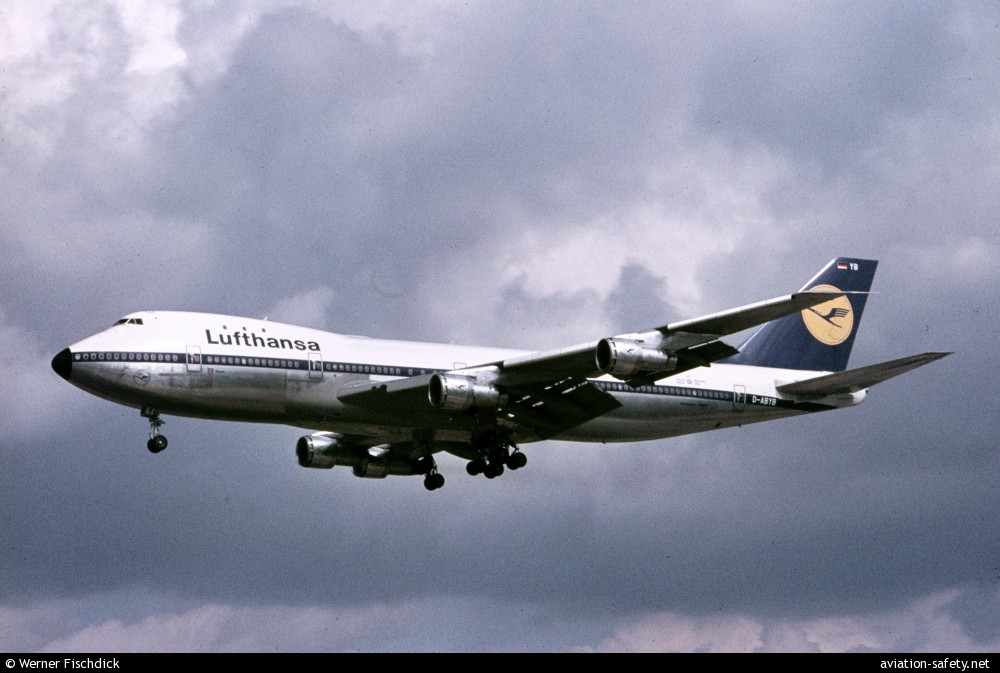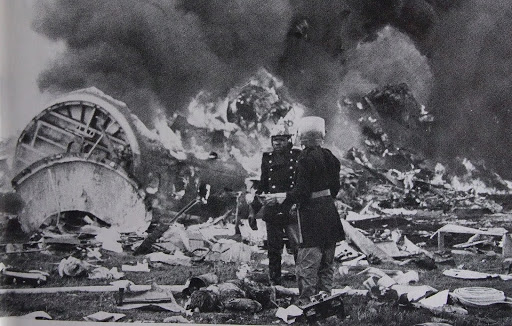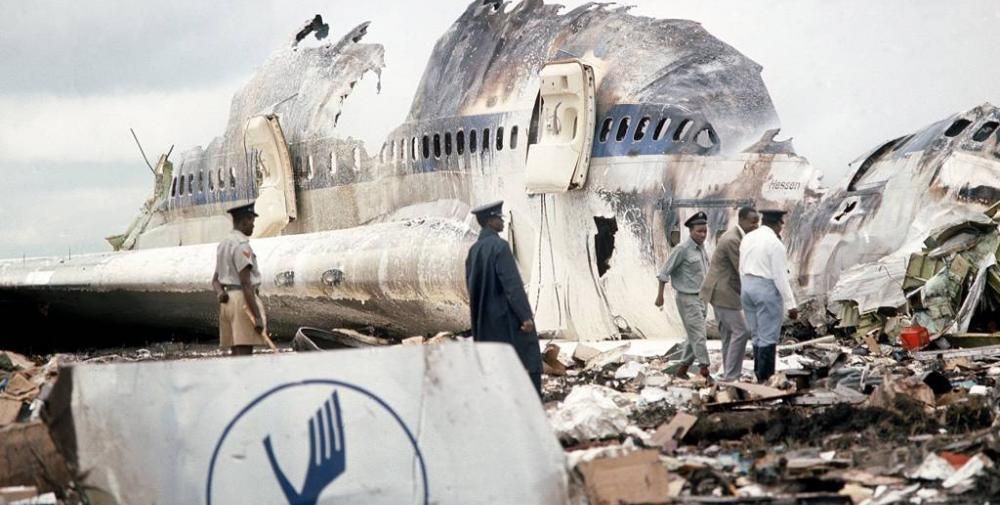20 November 1974 - Lufthansa 540
Lufthansa Flight 540, registered as D-ABYB, was a Boeing 747-130, carrying 157 people (140 passengers and 17 crew members), operating the final segment of its Frankfurt - Nairobi - Johannesburg route. On 20 November 1974 it crashed and caught fire shortly past the runway on takeoff. This was the first ever crash involving a Boeing 747.

As the aircraft was making its takeoff from runway 24 at the Jomo Kenyatta International Airport in Nairobi, the pilots felt a buffeting vibration. The captain continued the climb and retracted the landing gear. However, as this was being done, the aircraft started to descend and the stall warning system light came on. The aircraft continued to descend and approximately 3,700 feet (1,100 m) from the end of the runway, the 747 grazed bushes and grass. It then struck an elevated access road and broke up. The left wing exploded and fire spread to the fuselage. Of the 157 people aboard, 59 perished (55 passengers and 4 crew members).
Efforts by crew members saved a number of lives. Thomas C. Scott, a commercial pilot working the flight as a cabin crew member, was credited with saving the lives of a dozen passengers before the fuselage exploded by carrying the injured and escorting the dazed. Survivors included German-born American Jews who were returning from a Holocaust pilgrimage.
The cause of the crash was determined to be a stall caused by the leading edge slats having been left in the retracted position. Without slats deployed, the aircraft's stalling angle of attack was much lower, especially at a hot and high airport like Nairobi's with its airport elevation of 5,327 feet (1,624 m). The thinner air at higher altitudes generates less lift and further degrades the aircraft's ability to handle high angles of attack, as well as reducing the thrust provided by the 747's four turbofan engines.
The elevation and temperature at the airport were within the capability of the 747, but only with slats extended. With slats retracted, the aircraft lacked sufficient lift and thrust to continue climbing once out of the ground effect found near the surface. The flight engineer was found to have failed to open the bleed air valves as required on the pre-flight checklist, preventing engine bleed air from flowing to the 747's pneumatic system and keeping it from working. This prevented the slats from deploying during takeoff.
The flight crew was blamed for not performing a satisfactory pre-take-off checklist, but the accident report also faulted the lack of adequate warning systems which could have alerted the crew to the problem. Two previous occurrences of this error had been reported, but in those cases the pilots had been able to recover the aircraft in time. After this third, deadly incident Boeing added systems to warn pilots if such conditions existed prior to takeoff.

Transcript of the Cockpit Voice Recorder (CVR)
At 07.42 hrs local time the engines of the Lufthansa Boeing 747, flight number LH540, were started. In the cockpit was Commander Captain Christian Krack, Co-pilot Joachim Schacke and Flight Engineer Rudi Hahn. There were 157 people aboard including the crew, this gave a total estimated take-offweight, including baggage and freight, of 254,576 Kg (561,236lbs). Co-plot was designated the handling pilot for the first sector of flight, the crew carried out the preliminary checks. Engines were started at 07.42 hrs and after further pre-flight checks the Nairobi control radioed to the crew:
Nairobi Tower: "Lufthansa five four zero. Nairobi Tower"
Co-pilot Schacke: "Five four zero, go ahead"
Nairobi Tower: "Roger. You may take runway two-four at your discretion or
runway zero-six. Your choice."
Captain Krack: "Oh-two-four, okay"
Co-pilot Schacke: "We take two-four"
Nairobi Tower: "Roger. Cleared to taxi holding point, runway two-four."
Co-pilot Schacke: "Roger. We are cleared to holding point, runway two-four.
Are we cleared to enter?"
Nairobi Tower: "Lufthansa five four zero. That is approved. Enter and backtrack."
Co-pilot Schacke: "Roger. Thanks.
Co-pilot Schacke: (to the Captain) "So the flaps"
Captain Krack: "Yes"
Co-pilot Schacke: "So, shall I do the rowing? (handle takeoff)
Captain Krack: "Yes please"
Flight Engineer Hahn: "Checklist, brakes"
Co-pilot Schacke: "Are checked"
Flight Engineer Hahn: "Flaps"
Captain Krack: "Ten, ten, green."
Flight Engineer Hahn: "Flight controls" (indistinct reply)
Flight Engineer Hahn: "Yaw damper"
Captain Krack: "Checked"
Flight Engineer Hahn: "Flight instruments and annunciator panels"
Captain Krack: "No warnings"
Co-pilot Schacke: "No warnings here"
The flight crew continued with the checklist...
Captain Krack: "Cabin report received"
Flight Engineer Hahn: "Checklist completed"
Time 07.41
Nairobi Tower: "Lufthansa five four zero, your clearance"
Co-pilot Schacke: "Go ahead"
Nairobi Tower: "ATC clears Lufthansa five four zero Nairobi to Jan Smuts
delta amber one zero. Climb and maintain flight level three five zero
to Mike Bravo Mbeya Echo departure and check clearabnce expires at
five six. Time is now five one"
The crew completed the the take-off checklist.
Flight Engineer Hahn: "Take-off list is completed"
Co-pilot Schacke: "Okay"
The throttles were set to the correctly calculated 3A take-off power and
the 747 began to move forward down the runway.
Co-pilot Schacke: "Eighty"
Captain Krack: "Yes...Okay"
Captain Krack: "V1"
Captain Krack: "VR"
Captain Krack: "Pay attention. Vibration...."
Flight Engineer Hahn: "All is OK"
Captain Krack: "Vibration"
Co-pilot Schacke: "Gear up"
Co-pilot Schacke: "Gear travelling"
Flight Engineer Hahn: "Engines okay sot far"
Captain Krack: "Roger"
Flight Engineer Hahn: "RPM also okay"
Flight Engineer Hahn: "Stickshaker"
Co-pilot Schacke: "Okay, crash!"
Wheels up warning horn began to sound.
[End of Recording]
[This is the Accident Investigation Report Summary.]
The East African Community report was officially released in Nairobi
in July 1976. A summary described the accident:
The aircraft was operating Lufthansa flight 540/19, a scheduled
international passenger and cargo service from Frankfurt, Germany,
to Johanneburg, South Africa, with an intermediate stop at Nairobi.
During the takeoff from Nairobi the crew felt vibration or buffeting
after liftoff and suspected engine trouble. Subsequently the
Commander, suspecting wheel impalance, raised the landing gear.
The co-pilot, who was handling the aircraft, noticed a complete lack
of acceleration and had to lower the nose in an attempt to maintain
airspeed.
The aircraft lost altitude and the rear fuselage made contact with
the ground approximately 1120 metres beyond the departure end of
runway 24. Parts of the aircraft struck an elevated road 114 metres
further on and it started to break up.
The main portion skidded an additional 340 metres during which time
it turned to the left through approximately 180 degrees. The aircraft
was destroyed by impact and subsequent fire.
Cause:
The accident was caused by the crew initiating a takeoff with the
leading edge flaps retracted, because the pneumatic system which
operates them had not been switched on. This resulted in the
aircraft becoming airborne in a partially stalled condition which
the pilots were unable to identify in the short time available to
them for recovery.
Major contributory factors were:
1. Lack of warning of a critical condition of leading edge flap
position.
2. The failure of the crew to satisfactorily complete their
checklist items.

Recommendations
It is recommended that:
1. The takeoff configuration aural warning system programme on
Boeing 747 aircraft should be modified to include leading edge
flap position.
2. The takeoff configuration aural warning system on Boeing 747
aircraft should be excluded from the list of allowable
deficiencies.
3. Consideration should be given to the incorporation of leading
edge flap position in the aircraft's stall warning programme.
4. Consideration be given to the incluslion of a pneumatic duct
low pressure warning on the Pilot's Annunciatior Panel.
5. Consideration be given to amending operating procedures where
necessary to include a cross-check by the Commander of important
items on the flight engineer's panel.
6. In Boeing 747 and similar aircraft, States of Registry should
require the carriage of a multi-channel flight data recorder
compatible with ARINC 573 or equivalent characteristic.
7. In Boeing 747 and similar aircraft, consideration should be
given by States of Registry to require the installation and use
of hot microphone cockpit voice recorder circuits during the
takeoff, approach and landing phases.
8. Implementation of adequate international incident reporting
procedures, as initiated in the Accident/Incident Reporting
System (ADREP) of the International Civil Aviation Organisation,
including effective follow-up action, should be enforced.

